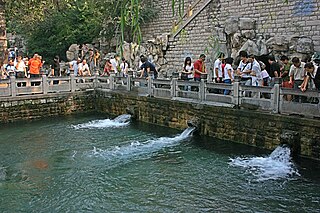 W
WThe Baimai Springs are a group of artesian karst springs located in Mingshui Subdistrict, Zhangqiu District, Jinan, Shandong Province, China about 25 kilometres west from the city centre of Jinan. The site of the springs is renowned for its natural beauty and as the one-time residence of the female Song Dynasty poet Li Qingzhao.
 W
WThe Baotu Spring is a culturally significant artesian karst spring located in the city of Jinan, Shandong, China. It is mentioned in the Spring and Autumn Annals, one of the Five Classics of Chinese literature, and was declared the "Number One Spring under the Heaven" by the Qianlong Emperor in the Qing dynasty.
 W
WThe Black Tiger Spring (Chinese: 黑虎泉; pinyin: Hēi Hǔ Quán) is a culturally significant artesian karst spring located in the city of Jinan, Shandong Province, China. The spring is ranked as the second most significant among the 72 named springs in Jinan. The water of the spring stems from moderately-deep circulation and emerges from a water-filled limestone cave in a steep cliff. From the mouth of the cave, the water is funneled to flow out of the mouths of three ornamental stone-carved tiger heads into a square-shaped spring pool. From there it runs into the old city moat, next to which the spring is located. According to the tradition, there was a black rock lying in front of the cave in ancient times. The name of the spring is said to be derived from the shape and color of the rock, which resembled a black tiger, and the sound of the water gushing past the rock being reminiscent of the roar of a tiger. The ancient layout of the spring is described in a poem by the Ming Dynasty poet, Yan Bizeng.
 W
WThe Cassock Spring, also called Dugu Spring or Yinquan Spring, is a culturally significant artesian karst spring on the grounds of the Lingyan Temple in the city of Jinan, Shandong Province, China. The name Cassock Spring refers to a piece of cast iron that is positioned at the edge of the spring pool and resembles a cassock. The Cassock Spring is listed among the "seventy-two famous springs", a list of springs in Jinan that has been kept and updated since the times of the Jin, Ming, and Qing Dynasties.
 W
WHupao or Dreaming of the Tiger Spring is a spring and park in southwestern Hangzhou, Zhejiang province, China.
 W
WThe Five Dragon Pool is a culturally significant pond fed by artesian karst springs in the city of Jinan, Shandong Province, China. It is one of the best known springs among the 72 famous springs of Jinan.
 W
WThe Five Lotus Spring is an artesian karst spring located in the city of Jinan, Shandong Province, China. The spring is located in the old city moat to the southeast of the historical city centre. A spring pool with a water level above that of the moat is formed by an arrangement of natural rocks.
 W
WHua Hill (Shandong) is a solitary cone-shaped hill in the lower Yellow River valley, located at the northeastern edge of the city of Jinan, Shandong Province, China. The hill is known for its cultural and historical significance as well as for its natural environment. It has been an inspiration for Chinese artists for many centuries and was the site of the Battle of An, a major battle fought during the Spring and Autumn period.
 W
WThe Pearl Spring is a culturally significant artesian karst spring located in the city of Jinan, Shandong Province, China. The Pearl Spring is located on the bottom of in a square spring pool that is surrounded by a stone fence on all sides. The water flows off through a canal into the Daming Lake. The spring was incorporated into the garden of a governor in the year 1466 and the provincial government continued to reside in vicinity of the spring until the 19th century . The name of the spring is said to be related to the bubbles forming in the spring.
 W
WThe Second Spring or Second-best Spring under Heaven is the name of a spring in Xihui Park at the foot of Mount Hui. The park is located in western Wuxi in eastern China's Jiangsu province.